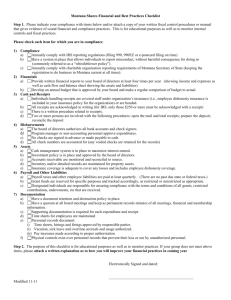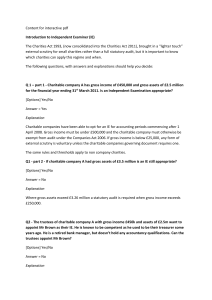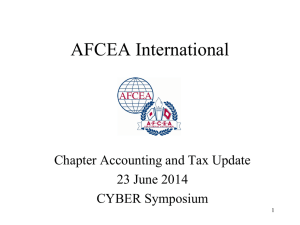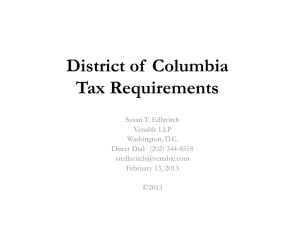this document
advertisement
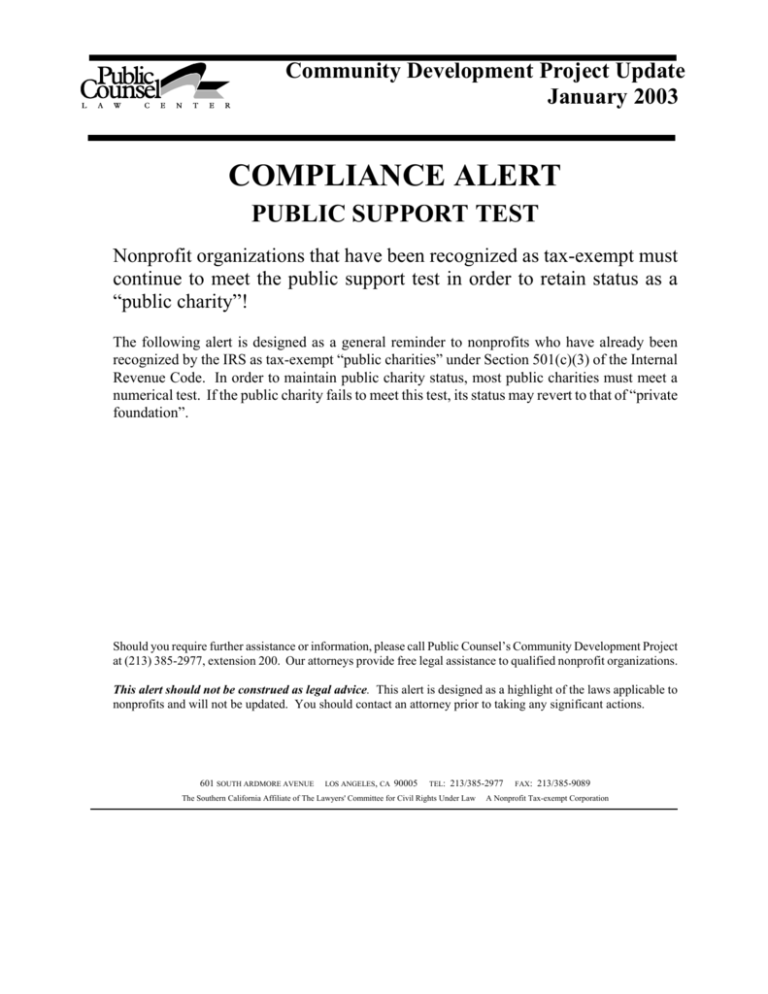
Community Development Project Update January 2003 COMPLIANCE ALERT PUBLIC SUPPORT TEST Nonprofit organizations that have been recognized as tax-exempt must continue to meet the public support test in order to retain status as a “public charity”! The following alert is designed as a general reminder to nonprofits who have already been recognized by the IRS as tax-exempt “public charities” under Section 501(c)(3) of the Internal Revenue Code. In order to maintain public charity status, most public charities must meet a numerical test. If the public charity fails to meet this test, its status may revert to that of “private foundation”. Should you require further assistance or information, please call Public Counsel’s Community Development Project at (213) 385-2977, extension 200. Our attorneys provide free legal assistance to qualified nonprofit organizations. This alert should not be construed as legal advice. This alert is designed as a highlight of the laws applicable to nonprofits and will not be updated. You should contact an attorney prior to taking any significant actions. 601 SOUTH ARDMORE AVENUE LOS ANGELES, CA 90005 TEL: 213/385-2977 The Southern California Affiliate of The Lawyers' Committee for Civil Rights Under Law FAX: 213/385-9089 A Nonprofit Tax-exempt Corporation Public Support Test If you have received a letter from the IRS stating you have been recognized as tax-exempt under Section 501(c)(3) of the Internal Revenue Code, you have already been designated either as a private foundation or a public charity. This alert is designed to remind organizations designated as a 501(c)(3) public charity that they must meet certain numerical tests in order to retain such status. Public Charity Status Generally, public charity status is more favorable than private foundation status. While both public charities and private foundations are classified under IRS Code Section “501(c)(3)”, private foundations are subject to much more complex and restrictive laws. Among other things, private foundations must pay a 1% or 2% excise tax on investment income, and must meet certain annual distribution requirements. Additionally, donors to private foundations may generally take a deduction for gifts of assets on a cost-basis – whereas public charity donors may generally take deductions up to the fair market value of the donated asset. If an organization has been designated a public charity and fails to meet the applicable “public support” test over a four year cumulative period*, this will be evidenced when it files its form 990 at the end of each year with the IRS. The IRS may eventually notify the organization that its status has reverted to that of private foundation. At such time, the organization will still be classified as taxexempt under Section 501(c)(3), but, within Section 501(c)(3), it will have private foundation status. The organization would then no longer be able to report to its donors that it is a “public charity.” Which Test Applies? Organizations designated as 501(c)(3) public charities will usually be described under either Internal Revenue Code Section 509(a)(1) or 509(a)(2)1. Your IRS determination letter (recognizing your taxexempt status) will indicate the code section your organization falls under. This is important because it will tell you which of the applicable tests your organization is subject to. 1) 509(a)(1) and 170(b)(1)(A)(vi) Organizations Test If an organization is classified by the IRS under Section 509(a)(1), it must meet the test designated for such organizations. The organization must show (over a four year cumulative period) that it normally either: a) b) receives at least one third of its total revenue from “public sources”, which include government grants, membership fees and/or contributions made directly or indirectly by the general public (including from other publicly supported organizations); OR receives at least one tenth of its total revenue from the above sources, and also show that it expects to attract more public support through, among other things, a program geared towards 1 There are some categories of public charities to which the public support test does not apply. Among these are “supporting organizations”, churches, schools and colleges, hospitals and governmental units. continuous solicitation of funds. Generally under this test, the organization will have to show that it receives one third of its support from public sources. If an organization cannot show 1/3rd support, it may resort to the “Facts and Circumstances Test” outlined in 1(b) above. Under the Facts and Circumstances Test, the IRS will permit an organization to receive less than one third (as low as 1/10th ) public support, on a showing that the organization is continuously attracting public support. The organization would have to show this by maintaining a continuous program for solicitation of funds. Additionally, the organization would want to show that its governing body was made up of individuals representing broad public interests (e.g. public officials and community leaders), and that its facilities are continuously available to the public. 2) 509(a)(2) Organizations Test If an organization is classified by the IRS under Section 509(a)(2), it must meet the test designated for such organizations. The organization must show (over a four year cumulative period) that it normally: a) b) receives at least one third of its revenues from certain “public sources”, including: • government grants, membership fees and/or contributions made directly or indirectly by the general public (including from other publicly supported organizations), and • gross receipts from admissions, sales of merchandise, and performance of services in any activity which furthers the organization’s charitable purpose; AND receives not more than one third of its support each year from the sum of its (a) gross investment income; and (b) the excess of any unrelated business income over the amount of tax imposed on such income. Note that a 509(a)(2) organization may include gross receipts from admissions, sales of merchandise and performance of services related to its charitable purpose within the definition of “public source,” while a 509(a)(1) organization may not. This test makes it appropriate for many 501(c)(3) groups to include receipts from performing exempt purposes (e.g. sale of goods or services) as public support, and is suitable to organizations that are self-sustaining rather than those that are primarily reliant upon grants and contributions. The above descriptions are summaries of each test and do not comport to be a complete description. In fact, there are many variables to each test. For instance, generally, any grant that exceeds 2% of an organization’s total support, may not be treated as a “public source.” Please refer to the chart below for a summary of the detailed factors applied in calculating each test, and contact an attorney or an accountant who has experience with tax-exempt organizations for further information. *Testing Period for Public Support: An organization that has a final ruling of public charity status must demonstrate to the IRS each year on Schedule A of its IRS Form 990 tax return that it continues to meet the applicable public support test. The test is applied on an average basis over the four preceding tax years. Comparison of Public Support Tests IRC Section 509(a)(1) and 170(b)(1)(A)(vi) IRC Section 509(a)(2) Organization must generally receive at least 1/3 of its support from public sources Organization must receive at least 1/3 of its support from public sources (excluding gross receipts from charitable activities). (including gross receipts from charitable activities); AND must not receive more than a third of its support each year from (a) gross investment income; and (b) the excess of any unrelated business income over the amount of tax imposed on such income. Public Sources 1/3 33% (excludes gross receipts) 32% 33% Public Sources 1/3 (includes Total Support gross receipts) (excludes gross 100% Total Support (includes gross receipts) receipts) Gross Investment Income Less Than 1/3 100% Public Sources include, generally: gifts and grants from public charities, gifts and grants from private sources (e.g. individuals, private foundations, corporations, etc.), government grants, membership fees, tax revenues, and the value of governmental Public Sources include, generally: gifts and grants from private and public sources (including government and membership fees) and gross receipts from exempt services rendered without charge. Total Support includes, generally: gifts and grants from public and private sources, purpose (charitable) activities (e.g. sales of goods/services). government grants, membership fees, income from unrelated business activities, gross investment income, tax revenues, and the value of governmental services Total Support includes, generally: all public sources from the 509(a)(1) test, AND receipts from exempt purpose activities. rendered without charge. th rd May resort to the 1/10 support test if unable to show 1/3 public support. No fallback test is available. What, specifically, constitutes a “public source”, and what is included in the definition of “total support”? • Contributions from private sources (including from board members, individuals, • Contributions from individuals, corporations, and government units are public corporations, and private foundations) and membership fees are public support to support. If the contribution, however, exceeds the greater of $5,000 or 1% of the the extent they do not exceed 2% of the total support. organization’s total support, the excess will not be public support. • Grants and contributions from public charities and governmental sources are not • Contributions from board members, substantial contributors, founders, certain subject to the 2% limitation outlined above related persons, private foundations, 509(a)(3) supporting organizations, and other 509(a)(2)'s do not count as public support but are included as total support. • Gross receipts from activities furthering the charitable purpose are not included • Gross receipts from exempt (charitable) purpose activities are public support to the either as public support or as total support. extent they do not exceed the greater of $5,000 or 1% of total support from one source in a single year's time. • Generally, investment income is not included as public support but is included as • Investment income is not included as public support, but as total support, and total support. (together with any unrelated business income less the tax imposed) is limited to 1/3rd of the total support.
